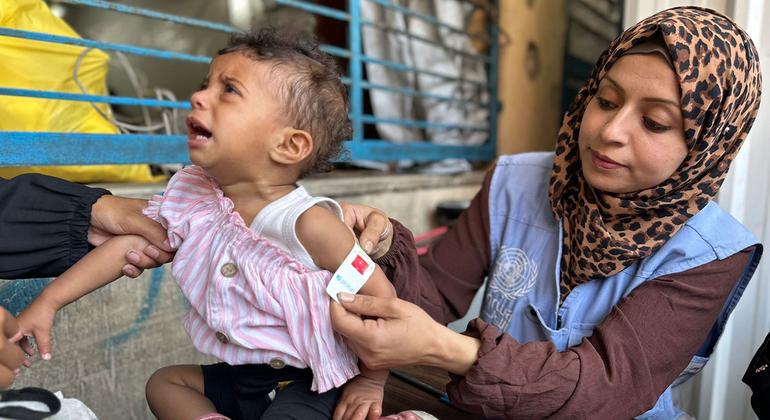“The fact that people are now dying every day trying to get food, I think is the starkest illustration of how desperate the situation is,” said Carl Skau, Deputy Executive Director at the UN agency, briefing journalists on his fourth visit to the war-torn enclave.
Earlier this year, food security experts reported that starvation is spreading in Gaza. The entire population, some two million people, is acutely food insecure and half a million are on the brink.
“If anything, it’s much worse now,” said Mr. Skau, who was in Gaza City, Deir Al-Balah and Khan Younis last week.
Children going hungry
Malnutrition is also surging. Some 90,000 children are in urgent need of treatment, according to UN child rights agency UNICEF.
Today, one in three people goes hungry for days. Mr. Skau said he met many families who told him there are days when their children do not eat at all.
“But the days when they are eating it’s often a hot soup they get from us with just a few lentils or a few pieces of pasta, so certainly not enough,” he said, adding that some mothers discourage their children from playing to conserve energy.
The top official also addressed the widespread displacement in Gaza. In the past he met families who had been forced to flee two or three times, but now “I meet families who have moved two or three times in the past 10 days,” and some who have been uprooted upwards of 20 times.
Trickle of aid
Meanwhile, outside of the recent 80-day aid blockade, humanitarian response “has never been more constrained.” The amount of assistance humanitarians are able to bring into Gaza is “just a fraction of what’s needed,” at a time when a kilo of wheat flour costs $25.
He added that the operating environment “is just impossible.” Active military operations are occurring in roughly 85 per cent of Gaza’s territory and teams “get stuck waiting for clearances and at checkpoints, often spending between 15 to 20 hours straight in their armoured vehicles trying to escort our convoys.”
Other obstacles include lack of fuel, spare parts for vehicles, and basic communications equipment.
Engagement with Israel
Mr. Skau said WFP have been actively engaging with the Israeli authorities over the past few weeks and “there were commitments” around issues such as volumes of aid, faster humanitarian movements, and not having the Israel Defense Forces (IDF) present when convoys are moving.
“Now, obviously, the proof is in the pudding,” he said. “We need now to see delivery and implementation on those commitments, and so far, we have not seen enough progress.”
He noted that WFP were allowed to deliver aid through the north on Friday for the first time in several days, which was “a key issue.”
“It’s not only about getting enough volumes, but it’s also to be able to get in through the north because in the north we are able to deliver in a more orderly way,” he said.
He told journalists that “there have been issues with armed elements interfering” in the region, which is unacceptable, but stressed the importance of being able to deliver there “because we think that is the way to also help bring down the levels of desperation and prices.”
Ceasefire now
Mr. Skau stated that the minor progress regarding commitments “is not going to be enough to turn the tide of hunger,” underlining the urgent need for a ceasefire in Gaza.
During the ceasefire earlier this year, WFP facilitated the entry of more than 8,000 trucks into the enclave, opened 25 bakeries and hundreds of soup kitchens, and delivered food packages to more than 1.5 million people.
The agency was also able to stock its warehouses, meaning operations could continue for roughly half of the 80-day blockade.
“We are ready to do that again,” said Mr. Skau. “We have enough food on the borders to deliver to the entire population for some two months. But obviously we need that ceasefire, and we need conditions within that ceasefire.”
Here, he stressed the need for a humanitarian protocol with a provision that allows for multiple routes and entry points into and inside Gaza – as well as a secure environment for delivery.
Later, Mr. Skau was asked about the talks with Israel.
“I sense the recognition that conditions need to improve,” he said. “It was also recognised that the UN has a key role to play,” he added.
“It was very clear in my engagement that they want the UN to continue to be the main track in delivery.
“And certainly should there be a ceasefire, the indications were that they would want us to be ready to scale up and do what we did last time when we on Day One were ready to bring 600 trucks into Gaza.”



